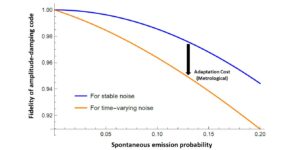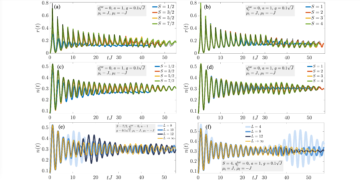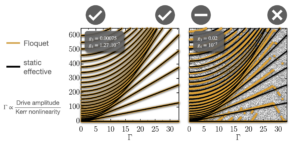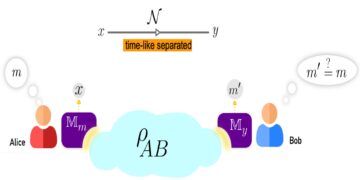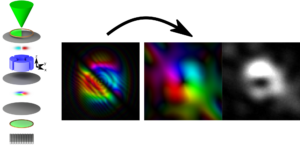1Dipartimento di Fisica, Università degli Studi di Pavia, Via Agostino Bassi 6, I-27100, Pavia, Italy
2INFN Sezione di Pavia, Via Agostino Bassi 6, I-27100, Pavia, Italy
3Instytut Fizyki imienia Mariana Smoluchowskiego, Uniwersytet Jagielloński, ulica Profesora Stanisława Łojasiewicza 11, PL-30-348 Kraków, Poland
Find this paper interesting or want to discuss? Scite or leave a comment on SciRate.
Abstract
We compare the proposals that have appeared in the literature to describe a measurement of the time of arrival of a quantum particle at a detector. We show that there are multiple regimes where different proposals give inequivalent, experimentally discriminable, predictions. This analysis paves the way for future experimental tests.
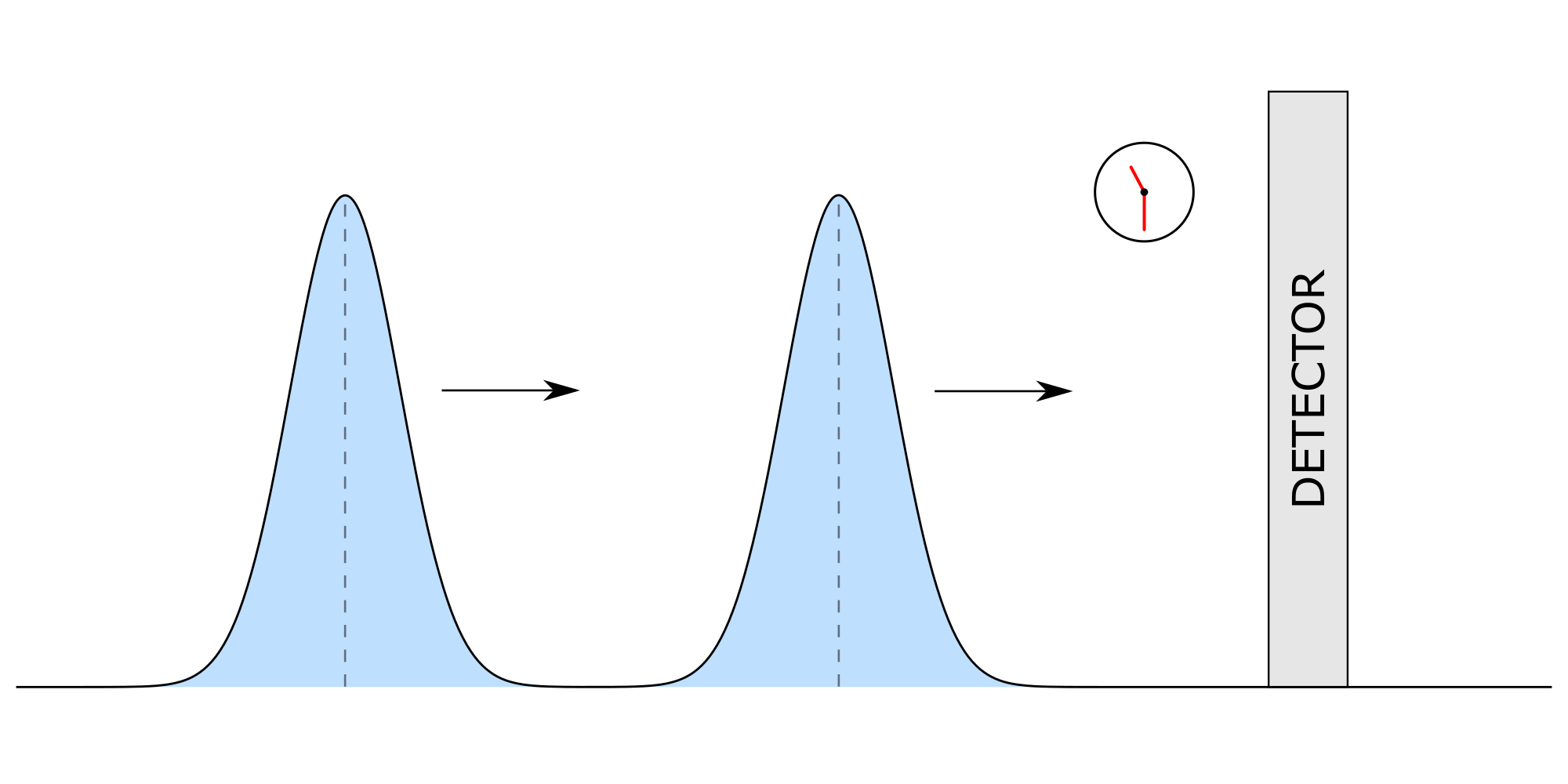
Featured image: A particle prepared in a superposition of two Gaussian wave packets. When the packets overlap near the detector, time of arrival interference is observed.
Popular summary
We identify realizable regimes for experimentally discriminating these approaches. Our results show that discrepancies appear in strongly quantum regimes, namely when the particle displays quantum interference in the time of arrival: destructive interference at times when it is less likely to detect the particle, constructive interference when detection is more likely to happen.
► BibTeX data
► References
[1] W. Pauli, General Principles of Quantum Mechanics (Springer, 1980).
https://doi.org/10.1007/978-3-642-61840-6
[2] N. Vona and D. Dürr, The role of the probability current for time measurements, in The Message of Quantum Science: Attempts Towards a Synthesis, edited by P. Blanchard and J. Fröhlich (Springer, 2015) Chap. 5.
https://doi.org/10.1007/978-3-662-46422-9_5
[3] R. P. Feynman and A. R. Hibbs, Quantum Mechanics and Path Integrals (McGraw-Hill, 1965).
[4] S. Das and W. Struyve, Questioning the adequacy of certain quantum arrival-time distributions, Phys. Rev. A 104, 042214 (2021).
https://doi.org/10.1103/physreva.104.042214
[5] Y. Aharonov and D. Bohm, Time in the quantum theory and the uncertainty relation for time and energy, Phys. Rev. 122, 1649 (1961).
https://doi.org/10.1103/PhysRev.122.1649
[6] N. Grot, C. Rovelli, and R. S. Tate, Time of arrival in quantum mechanics, Phys. Rev. A 54, 4676 (1996).
https://doi.org/10.1103/PhysRevA.54.4676
[7] E. A. Galapon, F. Delgado, J. G. Muga, and I. L. Egusquiza, Transition from discrete to continuous time-of-arrival distribution for a quantum particle, Phys. Rev. A 72, 042107 (2005).
https://doi.org/10.1103/physreva.72.042107
[8] J. Kijowski, On the time operator in quantum mechanics and the Heisenberg uncertainty relation for energy and time, Rep. Math. Phys. 6, 361 (1974).
https://doi.org/10.1016/S0034-4877(74)80004-2
[9] V. Delgado and J. G. Muga, Arrival time in quantum mechanics, Phys. Rev. A 56, 3425 (1997).
https://doi.org/10.1103/physreva.56.3425
[10] A. Ruschhaupt and R. F. Werner, Quantum mechanics of time, in The Message of Quantum Science: Attempts Towards a Synthesis, edited by P. Blanchard and J. Fröhlich (Springer, 2015) Chap. 14.
https://doi.org/10.1007/978-3-662-46422-9_14
[11] R. Werner, Screen observables in relativistic and nonrelativistic quantum mechanics, J. Math. Phys. 27, 793 (1986).
https://doi.org/10.1063/1.527184
[12] Y. Aharonov, J. Oppenheim, S. Popescu, B. Reznik, and W. G. Unruh, Measurement of time of arrival in quantum mechanics, Phys. Rev. A 57, 4130 (1998).
https://doi.org/10.1103/PhysRevA.57.4130
[13] T. Jurić and H. Nikolić, Arrival time from the general theory of quantum time distributions, Eur. Phys. J. Plus 137, 631 (2022).
https://doi.org/10.1140/epjp/s13360-022-02854-w
[14] Y. Aharonov and T. Kaufherr, Quantum frames of reference, Phys. Rev. D 30, 368 (1984).
https://doi.org/10.1103/PhysRevD.30.368
[15] Y. Aharonov, S. Popescu, and J. Tollaksen, Each instant of time a new universe, in Quantum Theory: A Two-Time Success Story (Springer, 2014) pp. 21–36.
https://doi.org/10.1007/978-88-470-5217-8_3
[16] C. Rovelli, Relational quantum mechanics, Int. J. Theor. Phys. 35, 1637 (1996).
https://doi.org/10.1007/bf02302261
[17] M. Reisenberger and C. Rovelli, Spacetime states and covariant quantum theory, Phys. Rev. D 65, 125016 (2002).
https://doi.org/10.1103/physrevd.65.125016
[18] D. N. Page and W. K. Wootters, Evolution without evolution: Dynamics described by stationary observables, Phys. Rev. D 27, 2885 (1983).
https://doi.org/10.1103/PhysRevD.27.2885
[19] L. Maccone and K. Sacha, Quantum measurements of time, Phys. Rev. Lett. 124, 110402 (2020).
https://doi.org/10.1103/PhysRevLett.124.110402
[20] V. Giovannetti, S. Lloyd, and L. Maccone, Quantum time, Phys. Rev. D 92, 045033 (2015).
https://doi.org/10.1103/physrevd.92.045033
[21] R. Brunetti, K. Fredenhagen, and M. Hoge, Time in quantum physics: From an external parameter to an intrinsic observable, Found. Phys. 40, 1368–1378 (2009).
https://doi.org/10.1007/s10701-009-9400-z
[22] S. Das and D. Dürr, Arrival time distributions of spin-1/2 particles, Sci. Rep. 9, 2242 (2019).
https://doi.org/10.1038/s41598-018-38261-4
[23] C. R. Leavens, Time of arrival in quantum and Bohmian mechanics, Phys. Rev. A 58, 840 (1998).
https://doi.org/10.1103/PhysRevA.58.840
[24] A. Ananthaswamy, Can we gauge quantum time of flight?, Sci. Am. 326, 1 (2022).
[25] J. G. Muga, R. S. Mayato, and I. L. Egusquiza, Time in Quantum Mechanics, Vol. 1 (Springer, 2008).
https://doi.org/10.1007/978-3-540-73473-4
[26] G. Muga, A. Ruschhaupt, and A. Campo, Time in Quantum Mechanics, Vol. 2 (Springer, 2009).
https://doi.org/10.1007/978-3-642-03174-8
[27] M. Kozuma, L. Deng, E. W. Hagley, J. Wen, R. Lutwak, K. Helmerson, S. L. Rolston, and W. D. Phillips, Coherent splitting of Bose-Einstein condensed atoms with optically induced bragg diffraction, Phys. Rev. Lett. 82, 871 (1999).
https://doi.org/10.1103/PhysRevLett.82.871
[28] S. Pandey, H. Mas, G. Drougakis, P. Thekkeppatt, V. Bolpasi, G. Vasilakis, K. Poulios, and W. von Klitzing, Hypersonic Bose–Einstein condensates in accelerator rings, Nature 570, 205 (2019).
https://doi.org/10.1038/s41586-019-1273-5
[29] C. R. Leavens, Spatial nonlocality of the “standard” arrival-time distribution, Phys. Lett. A 338, 19 (2005a).
https://doi.org/10.1016/j.physleta.2005.02.022
[30] C. R. Leavens, On the “standard” quantum mechanical approach to times of arrival, Phys. Lett. A 303, 154 (2002).
https://doi.org/10.1016/S0375-9601(02)01239-2
[31] S. Das and M. Nöth, Times of arrival and gauge invariance, Proc. R. Soc. A: Math. Phys. Eng. Sci. 477, 2250 (2021).
https://doi.org/10.1098/rspa.2021.0101
[32] I. L. Egusquiza, J. G. Muga, B. Navarro, and A. Ruschhaupt, Comment on: “On the standard quantum-mechanical approach to times of arrival”, Phys. Lett. A 313, 498 (2003).
https://doi.org/10.1016/S0375-9601(03)00851-X
[33] C. R. Leavens, Reply to Comment on: “On the ‘standard’ quantum-mechanical approach to times of arrival” [Phys. Lett. A 313 (2003) 498], Phys. Lett. A 345, 251 (2005b).
https://doi.org/10.1016/j.physleta.2005.08.004
[34] A. J. Bracken and G. F. Melloy, Probability backflow and a new dimensionless quantum number, J. Phys. A: Math. Theor. 27, 2197 (1994).
https://doi.org/10.1088/0305-4470/27/6/040
[35] K. V. Kuchar, Time and interpretations of quantum gravity, Int. J. Mod. Phys. D 20, 3 (2011).
https://doi.org/10.1142/S0218271811019347
[36] J. Leon and L. Maccone, The Pauli objection, Found. Phys. 47, 1597–1608 (2017).
https://doi.org/10.1007/s10701-017-0115-2
[37] B. S. DeWitt, Quantum theory of gravity. I. The canonical theory, Phys. Rev. 160, 1113 (1967).
https://doi.org/10.1103/PhysRev.160.1113
[38] M. Porrmann, Particle weights and their disintegration I, Commun. Math. Phys. 248, 269–304 (2004).
https://doi.org/10.1007/s00220-004-1092-9
[39] R. Gambini and J. Pullin, The solution to the problem of time in quantum gravity also solves the time of arrival problem in quantum mechanics, New J. Phys. 24, 053011 (2022).
https://doi.org/10.1088/1367-2630/ac6768
Cited by
[1] Ranjan Modak and S. Aravinda, “Non-Hermitian description of sharp quantum resetting”, arXiv:2303.03790, (2023).
[2] Tajron Jurić and Hrvoje Nikolić, “Passive quantum measurement: Arrival time, quantum Zeno effect and gambler’s fallacy”, arXiv:2207.09140, (2022).
The above citations are from SAO/NASA ADS (last updated successfully 2023-03-30 12:56:20). The list may be incomplete as not all publishers provide suitable and complete citation data.
Could not fetch Crossref cited-by data during last attempt 2023-03-30 12:56:18: Could not fetch cited-by data for 10.22331/q-2023-03-30-968 from Crossref. This is normal if the DOI was registered recently.
This Paper is published in Quantum under the Creative Commons Attribution 4.0 International (CC BY 4.0) license. Copyright remains with the original copyright holders such as the authors or their institutions.
- SEO Powered Content & PR Distribution. Get Amplified Today.
- Platoblockchain. Web3 Metaverse Intelligence. Knowledge Amplified. Access Here.
- Source: https://quantum-journal.org/papers/q-2023-03-30-968/
- :is
- ][p
- 1
- 10
- 11
- 1984
- 1994
- 1996
- 1998
- 1999
- 2011
- 2014
- 2017
- 2019
- 2020
- 2021
- 2022
- 2023
- 28
- 39
- 7
- 8
- 9
- a
- above
- ABSTRACT
- accelerator
- access
- adequacy
- affiliations
- All
- analysis
- and
- appear
- appeared
- approach
- approaches
- ARE
- arrival
- Art
- AS
- At
- Attempts
- author
- authors
- BE
- book
- Break
- by
- CAN
- certain
- Clock
- COHERENT
- comment
- Commons
- compare
- complete
- considered
- construction
- constructive
- continuous
- copyright
- could
- Current
- data
- describe
- described
- description
- Detection
- different
- difficult
- discuss
- displays
- distribution
- distributions
- during
- dynamics
- e
- each
- effect
- energy
- EUR
- evolution
- external
- flight
- FLUX
- For
- found
- from
- future
- General
- Give
- gravity
- happen
- harvard
- Have
- HOGE
- holders
- However
- HTTPS
- hypersonic
- i
- identify
- image
- in
- instant
- institutions
- interesting
- Interference
- International
- intrinsic
- IT
- JavaScript
- journal
- Last
- lead
- Leave
- License
- like
- likely
- List
- literature
- Main
- MAS
- math
- max-width
- measurements
- mechanical
- mechanics
- message
- Momentum
- Month
- more
- multiple
- namely
- Nature
- Near
- New
- normal
- number
- of
- on
- open
- operator
- original
- packets
- page
- Paper
- parameter
- passive
- path
- Physics
- plato
- Plato Data Intelligence
- PlatoData
- plus
- position
- Predictions
- prepared
- principles
- Problem
- PROC
- Proposals
- provide
- published
- publisher
- publishers
- Quantum
- quantum measurement
- Quantum Mechanics
- quantum physics
- Questions
- recently
- references
- registered
- relation
- remains
- reply
- Results
- Role
- s
- SCI
- Science
- Screen
- several
- sharp
- show
- Simple
- since
- solution
- Solutions
- Solves
- Spatial
- standard
- States
- Story
- strongly
- success
- success story
- Successfully
- such
- suitable
- superposition
- tests
- that
- The
- their
- These
- three
- time
- times
- Title
- to
- towards
- transition
- treat
- Uncertainty
- under
- Universe
- updated
- URL
- via
- volume
- von
- W
- Wave
- Way..
- with
- without
- year
- zephyrnet





